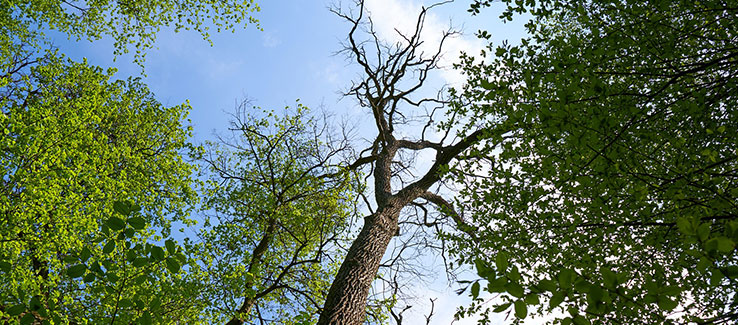Dying Oak Tree Symptoms and Solutions
Prevent catastrophic damage by knowing when your oak tree is dying. Knowing how to identify when an oak tree is troubled or in decline will help you save it or remove it before causing costly property or personal injury.
fasttreeremovalatlanta.com gathered the following information about dying oak tree symptoms, the diseases, the infestations, and other conditions to help you determine whether to treat or remove your oak tree.
Signs of A Dying Oak Tree
The following are indicators that your oak tree is dying and what actions should be taken to save your tree or remove it.
Tree Boring Insect Infestations
Boring insects like the southern pine beetle, red-headed ash borer, red oak borer, Asiatic oak weevil, and carpenterworms can be identified by the following:
- Small rounded exit holes
- Crown and branch dieback
- Deeply cracked Bark
- Cankers
- Foliage chlorosis and wilting
- Bulging bark (above the galleries)
- Sightings of adults feeding on the tree’s foliage
- Higher than normal squirrel activity
- Woodpecker activity
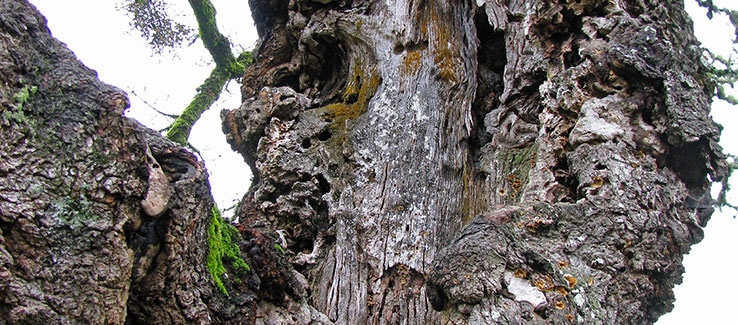
Many of these visible symptoms occur due to hydraulic failure or girdling caused by the boring insect’s tunneling through the tree’s cambium (xylem and phloem, which transport nutrients and water from the crown to the roots and back).
Note: If left unchecked, many boring insects will re-infest the host tree season after season until killing it.
Tree Boring Insect Solutions
Typically, by the time a boring insect infestation is discovered, it is exceptionally challenging to save the infested tree. The following should be done to contain the infestation:
- Set baited traps to catch emerging adults
- Chemically treat uninfected trees with residual insecticides such as carbaryl or pyrethroid insecticides such as bifenthrin or permethrin
- Carefully prune and destroy all affected branches
- When the infestation reaches the tree’s trunk, removal may be the only option (topical sprays and treatments will have no effect)
Tree boring insects typically attack the trees that are already in decline. You can help neighboring trees by promoting their health and vigorous growth.
Tip: Don’t try to eliminate a boring insect infestation alone. Contract an ISA certified arborist to guide you through your options.
Tree Fungal Infections
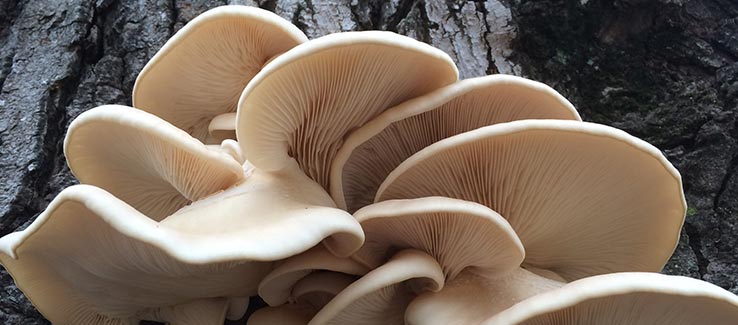
Healthy oak trees are highly resistant to fungal infections. That said, when an oak (or any other tree species) finds itself stressed, fungi can successfully attack the tree, making it its host. The following symptoms may indicate an advanced fungal infection:
- Cankers (discolored areas or depressed places on the bark)
- Bark swelling
- Twig and branch dieback
- Partial or total crown chlorosis (yellowing)
- Carpenter ants nesting in the tree (they don’t consume the wood, rather they remove decaying wood to form galleries within the heartwood)
- Mushroom Conks (fruiting structures) growing from the trunk or root flare
- Boring insect infestation••
**Ambrosia, oak wilt, and fusarium are examples of fungi using boring insects as their vector.
Tree Fungal Infection Solutions
Healthy trees are quite capable of compartmentalizing (sealing off) fungal infections. However, when a tree is stressed from drought, nutritional deficiencies, infestations, etc., infections can run wild and quickly overcome the tree. The following can be done to contain a fungal infection:
- Carefully prune and destroy (burn) infected limbs and branches (avoid pruning activities from mid-April to mid-July to reduce tree disease infection and spread)
- Sanitize all equipment before and after use on infected trees
- Nurture the tree, watering, mulching, and fertilizing it to encourage vigorous growth
- Avoid overhead watering or splashing water which can spread infections from tree to tree
- Use an insecticide to halt carpenter ant activities
- Apply fungicides as recommended by an ISA certified arborist
- Treat surrounding healthy trees and vegetation with copper fungicides (to avoid the infection’s spread)
Tip: For carpenter ant infestations, mix equal parts vinegar and water in a spray bottle, then spray the mixture into a carpenter ant nest. This should eradicate the entire colony.
Note: Most cases of fungal infections producing mushrooms on the trunk or roots or resulting from boring insect infestations will likely require removing the tree.
Brittle Tree Bark and Cracks
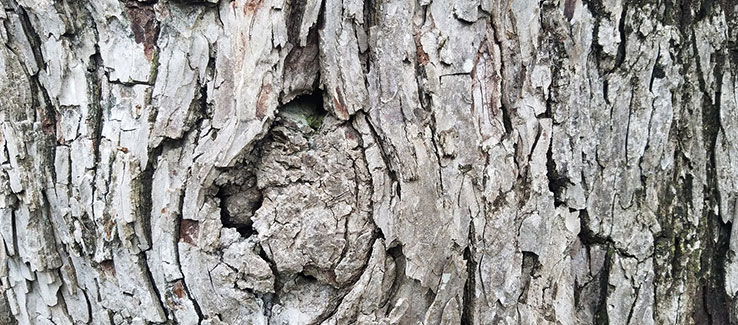
As a tree dies, bark may begin to slough off the tree. Verticle cracks may also form along the trunk or along limbs. Observe the following:
- When cracks in tree bark are spotted, inspect them to see if the crack has developed into the tree’s wood.
- Identify cracks that run into external or internal cavities.
Note: As a tree dies, it dries out, leading to such cracks, bark loss, and severe instability. Trees in this condition may suddenly topple, especially during storms.
Brittle Tree Bark and Crack Solutions
When sloughing tree bark and cracks are isolated in limbs and branches, you can do the following:
- Immediately prune out these branches
- Have a tree risk assessment performed by an ISA certified arborist
The urgency to remove this dead wood is to prevent the tree from dropping these limbs on its own (cladoptosis), potentially causing catastrophic damages.
Note: Sometimes, removing dead or dying branches is enough to save your tree or, at least, buy it some time. However, once this condition spreads to the tree’s trunk, it is better to have the tree removed before it falls or collapses under its own weight.
The Tree Is Leaning
Trees are highly efficient at maintaining balance throughout their life. However, severe weather events, root diseases (root rot), or irregular growth can cause a tree to destabilize and lean. Consider the following actions:
- Stake or brace the tree, slowly winching it back to an upright growth pattern (this often works for younger trees)
- Remove the tree before it completely destabilizes
Tip: Corrective actions should be taken under an arborists supervision.
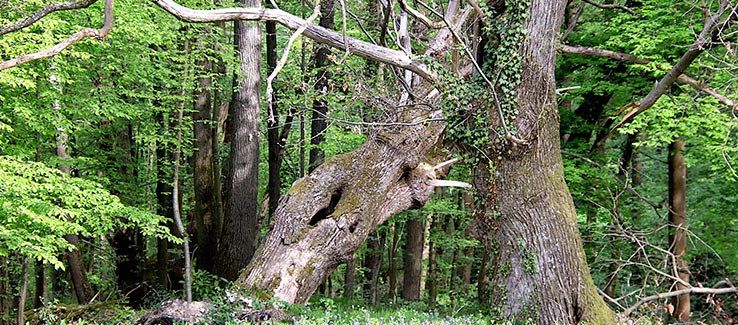
Note: Mature trees that have toppled or suffered windthrow in severe weather or winds are highly unlikely to ever recover.
How To Save a Dying Oak Tree
Sick trees will often display similar signs that a dying or dead tree would, but not as widespread. Not all trees displaying these conditions need to be removed immediately. Some of these conditions can be treated, prolonging the tree’s life.
The chances of saving your oak tree are reliant on your swift action, the amount of damage the tree has sustained, and your contacting an ISA certified arborist as soon as you detect any signs that your tree is in trouble.
Performing regular tree care and maintenance like pruning, disease and pest prevention measures, and correcting poor structural growth or damage will improve your tree’s health.
Dying Oak Tree Solutions
In this article, you discovered information on how to detect the symptoms of a dying oak tree, including the diseases, infestations, and conditions contributing to your tree’s declining condition.
Taking swift action to identify, treat, and get professional help for your tree significantly increases the chances of saving it.
Ignoring the signs of a declining tree leaves it vulnerable to infestations, infections, and structural problems that will lead to its rapid decline and death.
Sources:
agrilifeextension.tamu.edu/library/landscaping/wood-boring-insects-of-trees-and-shrubs/
canr.msu.edu/news/boring_insects_are_not_boring_theyre_serious_pests
uga.edu/publications/detail.html?number=B1286&title=Key%20to%20Diseases%20of%20Oaks%20in%20the%20Landscape
ceventura.ucanr.edu/newsletters/Vol_19,No4_-_December_200629825.pdf
apsjournals.apsnet.org/doi/pdf/10.1094/PDIS-01-13-0056-FE
fs.usda.gov/Internet/FSE_DOCUMENTS/stelprdb5349700.pdf
(404) 220-9965
(404) 220-9963

